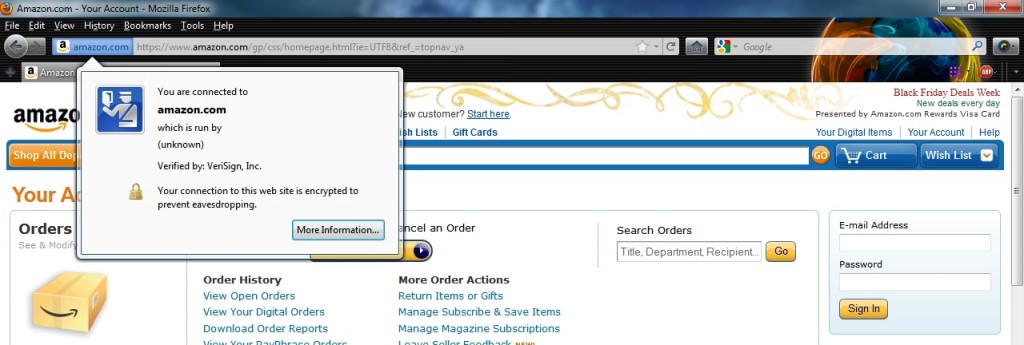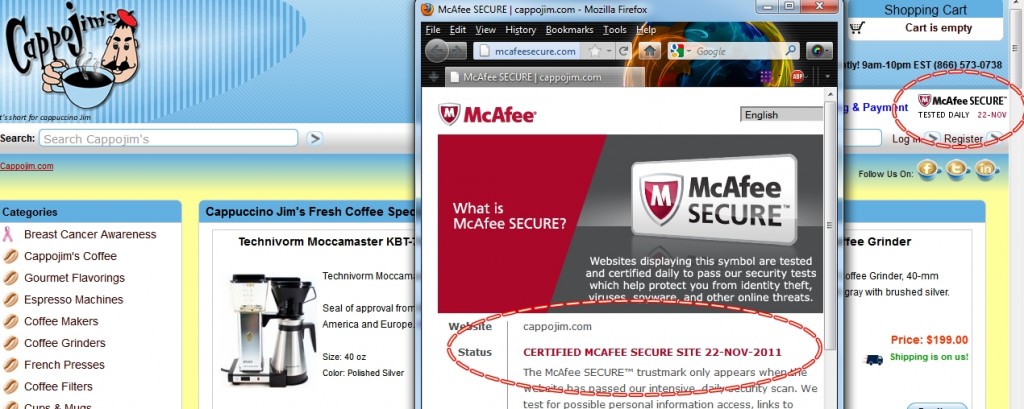Helpful Tips for Online Shopping
We see the horror stories on the news every holiday season– people getting trampled squeezing through the door of their favorite retailer trying to get their hands on one of the few “doorbuster” items that were advertised to draw the crowd. Those stories and experiences may be why Cyber Monday saw a whopping 20% increase in 2010 and ecommerce overall has been growing leaps and bounds.
Whether you’re a newbie to online shopping or not, below is a list of things to keep in mind while shopping online for that perfect gift:
1) Basic Online Security
Never submit your credit card information on a website that is not SSL-secured, and never email your credit card information for any reason. When you are on a page that is requesting your login user name and password or credit card information, your web browser should indicate that your connection is encrypted (click screenshot below to see how it should look.) Also, instead of the web address starting with http: it should start with https: (notice the “s”, which stands for “secure”.)
2) Trust But Verify
Legitimate ecommerce websites often take additional steps to protect their customer’s data by investing in a “trust seal” service such as McAfee Secure, VeriSign and Trustwave. By subscribing to services such as this, the website must conform to best-practice security standards for PCI Compliance, designed to protect sensitive data. But simply having those logos on a website does not mean they have a valid subscription to those services. If you click on a trust seal and it does not open a new browser window with verifying information from the trust mark service, the website owner illegally put the logo on their website and you should leave the website immediately (click screenshot below to see how it should work.)
3) Use a Credit Card (not a debit card)
If your credit card data is stolen as a result of making an online purchase, your maximum liability is $50.00, and the credit card company will issue you a new credit card. If your debit card information is stolen, the bad guys have access to your bank account and can do more damage. Plus your maximum liability is $500.00.
4) New, Used or Refurbished?
Consumers are often looking for great deals on electronics when purchasing online. Be aware that many websites (including Amazon) sell new, used and refurbished electronics. So be sure to read the fine print when looking at your favorite TV, laptop, etc. If the price seems unusually low, chances are it is a used or refurbished item. You may make an educated decision to purchase used or refurbished electronics, but make sure you understand their return policies and warranties before pressing that Buy Now button!
5) Restocking Fees
More online retailers are charging restock fees for returned items. It is a reasonable paradigm, since they have to repackage and put the item back in their inventory for resale. However, some online retailers have significantly high restock fees (20-30% of the cost of the item) so make sure you read the fine print before purchasing that $5000.00 55″ 3D HDTV. If it turns out it doesn’t fit through your front door and you have to return it, you could end up paying a $1500.00 restock fee plus shipping to get it back to them.
With these basic tips in mind and practicing safe surfing, you should have a happy holiday shopping season. Have fun and good luck finding that grand bargain!!

